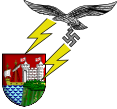
Fishponds Local History Society

The Luftwaffe over the Bristol area - Luftwaffe aircraft, identification markings, ranks & aircrew categories
LUFTWAFFE AIRCRAFT
At the start of operations against Britain the Luftwaffe was using three principle types of bomber, the Dornier Do 17, the Heinkel He 111 and the Junkers Ju 88, all twin-engined aircraft. So, with no four-engined bombers in its inventory, the Luftwaffe was incapable of lifting an enormous weight of bombs in one night. By the end of 1940 the obsolescent Do 17 was largely phased out and, from then on, the Ju 88 and He 111 carried on the battle almost exclusively until mid-1941. The Messerschmitt Bf 110 long-range fighter used as a light bomber also saw limited service during this period but its operations were usually confined to daylight precision attacks. All four types were also employed on reconnaissance duties.
The Do 217 introduced into service on the western front during the spring of 1941 was a development of the Do 17, just as the Ju 86R which first operated against Britain in August 1942 was an experimental development of the pre-war Ju 86. This was followed in May 1943 by the Messerschmitt Me 410 fighter-bomber, which replaced the Bf 110, and in August by the Ju 188, developed from the Ju 88.
The Luftwaffe's failure to develop a strategic bomber was a fundamental error on the part of the High Command, and one for which it was to pay dearly. The He 177, its belated attempt construct such an aircraft was a complete disaster, and although it commenced operations against Britain in early 1944 it was plagued with technical problems which were never successfully overcome.
AIRCRAFT IDENTIFICATION MARKINGS
Bomber, Heavy Fighter (Zerst�rer) and Reconnaissance units identified their aircraft by a four character coding system painted on the fuselage sides. The first two characters, to the left of the fuselage cross, were an arbitary identification code peculiar to each Geschwader or independent Gruppe. The third character was the individual aircraft identification letter, and the fourth and final letter in the code identified the Staffel according to a rigid sequence. For example an He 111 coded G1+AH :- The G1 to the left of the fuselage cross was the code for KG 55, while the H on the extreme right indicated that the aircraft belonged to the 1st Staffel (of the 1st Gruppe). The A was the identification letter of the individual aircraft within the Staffel. In addition all aircraft carried throughout their lives their own individual Werk Nummer (Wnr.) or airframe serial number which had been allocated by the manufacturer.
PRINCIPAL LUFTWAFFE RANKS
OFFICERS
Generalfeldmarschall (Gen. Feldm.) = Marshal of the RAF
Generaloberst (Gen. Oberst.) = Air Chief Marshal
General der Flieger (Gen. d. Fl.) = Air Marshal
Generalleutnant (Gen. Ltn.) = Air Vice Marshal
Generalmajor (Gen. Maj.) = Air Commodore
Oberst (Oberst) = Group Captain
Oberstleutnant (Oberstlt.) = Wing Commander
Major (Maj.) = Squadron Leader
Hauptmann (Hptm.) = Flight Lieutenant
Oberleutnant (Oblt.) = Flying Officer
Leutnant (Ltn.) = Pilot Officer
Leutnant zur See *(Ltn.z.S.) = Sub Lieutenant
* A Naval rank held by some members of mixed Airforce/Navy crewed units e.g. KGr 606, KGr 806.
NON-COMMISSIONED OFFICERS
Stabsfeldwebel (Sfw.) = Warrant Officer
Oberfeldwebel (Ofw.) = Flight Sergeant
Fahnenjunker-Fw. (Fhj-Fw.) = Cadet Sergeant Major
Feldwebel (Fw.) = Sergeant
Unteroffizier (Uffz.) = Corporal
OTHER RANKS
Obergefreiter (Ogefr.) = Leading Aircraftsman
Gefreiter (Gefr.) = Aircraftman First Class
Flieger (Flg.) = Aircraftman Second Class
CIVILIANS ENGAGED IN MILITARY OPERATIONS
Sonderf�hrer (Sdf.) = Kriegsberichter
War correspondents who usually flew as gunners.
LUFTWAFFE AIRCREW CATAGORIES
Flugzeugf�hrer (F) = Pilot
Beobachter (B) = Observer (Navigator/BombAimer)
Bordfunker (Bf) = Wireless (W/T) Operator
Bordmechaniker (Bm) = Flight Mechanic
Bordsch�tze (Bs) = Gunner
Bombensch�tze (Bsz) = Bomb Aimer (not fully trained)
Kampfbeobachter (Kb) = Combat Observer (not fully trained)
Website produced by Paul Johnson . Last updated 3 March 2014.